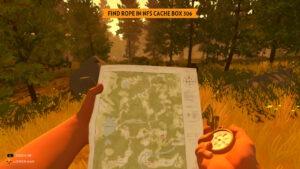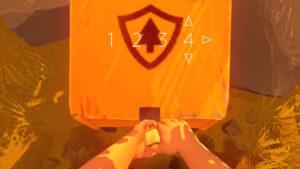Firewatch is a first-person adventure game created by Campo Santo for all popular gaming consoles (PlayStation, Xbox, Nintendo, Linux, Windows, and Apple products). The game is primarily made for young adults and up as there is some use of adult language and emotional content surrounding dementia and Alzheimer’s. If you read no further I would highly recommend you buy and play this game. It was incredibly engaging and had beautiful graphics and story.

The primary game mechanic present in Firewatch is walking around your designated sector to uncover new areas of the map, protect the forest, and eventually to uncover a mystery that surprisingly unfolds all around you. The use of these movement mechanics and the essential map and compass components lead to the aesthetic of discovery.

This map specifically played a huge role in ‘selling the space’. I consulted it constantly and noticed myself building a map in my head about what was where, I quickly wanted to become familiar with this space.
I spent much of my time playing this game taking in the stunning visuals of Wyoming and reflecting on the time I had spent there in my own life. This sense of nostalgia is further enforced as you play as Henry, whose wife has recently been diagnosed with early onset Alzheimer’s. Throughout the game your only words are exchanged with your dispatch officer, Delilah, through a radio that you carry on your expeditions. These conversations are filled with nostalgia as she asks you about who you were before this job, and you uncover more and more details about your past–adding a second layer of discovery about how you arrived here. In my experience playing the game, discovery was at the forefront of my experience and it even kept me playing well past the allotted two hours I had planned for. Discovering the map, solving the mini puzzles, and finding out who was stalking me was extremely motivating in continuing game play and enjoying the environment.

I particularly loved the beginning of this game as you flash in and out of remembering your past and hiking through the forest to get to your watch post. This was incredibly immersive and I loved the way these flashes simulated the real experience of hiking–seeing one thing, thinking of another.

In general the game play was great when there were tasks to complete and radio calls coming in. During these moments I felt I was really in the environment and was driven to uncover the mystery and fill new spaces in on my map. At other times though–particularly in the middle of the game–there is a long stretch of skipping days (the game progresses through time by noting the day number since you began your watch, sometimes skipping several at a time) with little game play and simply a radio signal. This change in pacing was something I didn’t expect, but came to realize was relevant in later game play. It made me feel less engaged and less immersed overall, so to change this I would have instead included a timelapse cutscene of sorts to show more immersively the passage of time to keep players engaged.
Overall I absolutely loved playing this game and have found out that first-person adventures / walking sims are my type of game! I will definitely be returning to this one in the future to find out what the hell is going on in this Wyoming forest.



